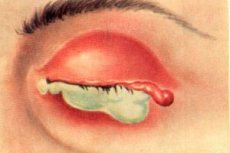Medical expert of the article
New publications
Gonobluenorrhea
Last reviewed: 07.07.2025

All iLive content is medically reviewed or fact checked to ensure as much factual accuracy as possible.
We have strict sourcing guidelines and only link to reputable media sites, academic research institutions and, whenever possible, medically peer reviewed studies. Note that the numbers in parentheses ([1], [2], etc.) are clickable links to these studies.
If you feel that any of our content is inaccurate, out-of-date, or otherwise questionable, please select it and press Ctrl + Enter.

Gonoblenorrhea (acute conjunctivitis caused by gonococcus) is a very serious eye disease. Gonoblenorrhea was especially common in newborns in pre-revolutionary Russia and often resulted in blindness. Currently, this serious eye disease in newborns is extremely rare and is observed in cases where the birth did not take place in a maternity hospital and no prophylaxis was taken.
Gonoblenorrhea develops when secretions containing Neisseria gonorrhoeae enter the conjunctiva. Gonococci can spread from the mucous membrane and lead to generalization of the infection with the development of diseases such as gonitis, myositis, endocarditis, etc.
Pathogens
Symptoms gonorrhea
A distinction is made between gonoblenorrhea in newborns, children and adults.
Gonoblenorrhea of newborns usually occurs on the 2nd-3rd day after birth. Infection occurs during the passage of the fetus through the birth canal of a mother who has gonorrhea. Infection can also occur through child care items and cause a later disease (later than 2-3 days).

At the beginning of gonoblenorrhea, the eyelids swell greatly, become very dense, so that they are difficult to open for examination. The conjunctiva is sharply hyperemic, edematous and bleeds easily. The discharge is scanty, serous in nature, with a small admixture of blood. After 3-4 days, the eyelids become less dense and abundant purulent discharge appears, yellow in color with a greenish tint. Gonococci are found in a smear of pus under a microscope.
The great danger of gonoblenorrhea is in the damage to the cornea. The edematous conjunctiva of the eyeball compresses the marginal looped network, disrupting the nutrition of the cornea. In the epithelium, which, in addition, is macerated due to the presence of abundant purulent discharge, purulent ulcers easily arise, resulting in perforation, and subsequently - in the formation of a coarse leukoma with a burning decrease in vision or even death of the eye. Before the introduction of sulfonamides and antibiotics into medical practice, the disease lasted up to 1.5-2 months, and complications from the cornea were often observed, ending in the formation of a leukoma and often blindness.
Gonoblenorrhea in adults is more severe than in newborns, more often affects the cornea, and is sometimes accompanied by a feverish state and joint damage. Infection occurs when the patient himself, suffering from gonorrheal urethritis, brings in secretions from the urethra. Medical personnel who care for patients with gonorrhea are also exposed to infection, for example, when examining a patient, when opening the amniotic sac, when examining a child suffering from gonococcal conjunctivitis, etc.
Childhood gonoblenorrhea is more severe than adult gonoblenorrhea, but more severe than newborns. Childhood gonoblenorrhea usually occurs in girls. Infection occurs from a sick mother if personal hygiene rules are not observed.
The diagnosis of gonoblenorrhea is finally established after a bacteriological examination of a smear from the conjunctiva; gonococci are found located intra- and extracellularly.
What do need to examine?
How to examine?
What tests are needed?
Who to contact?
Treatment gonorrhea
Treatment of gonococcal conjunctivitis consists of general and local administration of large doses of sulfonamides and antibiotics - washing the eye with a solution of boric acid, instillation of eye drops (Okatsil, Floxal or Penicillin) 6-8 times a day. Systemic treatment is carried out: quinolone antibiotic 1 tablet 2 times a day or penicillin intramuscularly. Additionally, instillations of antiallergic or anti-inflammatory drugs (Spersallerg, Allergoftal or Naklof) are prescribed 2 times a day. In case of keratitis, Vitasik, Karpozin or Taufon are also instilled 2 times a day.
In newborns, local treatment is the same as in adults, and systemic treatment involves the administration of antibacterial drugs in doses appropriate to age.
More information of the treatment
Prevention
Prevention of neonatal gonoblenorrhea consists of sanitation of the mother in the prenatal period. Immediately after birth, the child's eyelids are wiped with a cotton swab soaked in a 2% solution of boric acid, and 2% silver nitrate solution is instilled into each eye (the Matveyev-Crede method). Recently, antibiotic and sulfonamide solutions have been used for prevention. A freshly prepared penicillin solution (30,000 U in 1 ml of isotonic sodium chloride solution) or a 30% solution of sodium sulfacyl is instilled three times for 1 hour after preliminary treatment of the eyelids with a 0.02% solution of furacilin. Prevention of gonoblenorrhea in adults and children consists of careful observance of personal hygiene rules.

